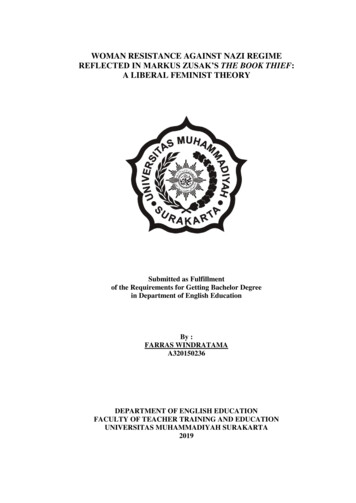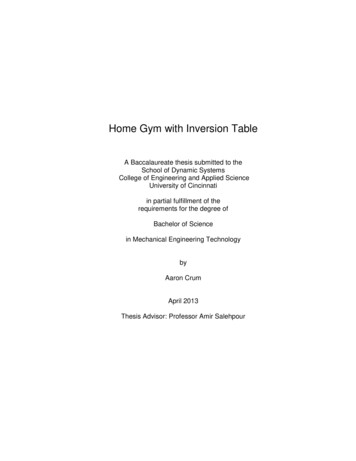
Transcription
“CHARGED WITH RESISTANCE”: AN ECOCRITICAL READING OFBARBARA KINGSOLVER’S PRODIGAL SUMMER AND FLIGHT BEHAVIORA ThesisbyBRENDAN T. HAWKINSSubmitted to the Graduate Schoolat Appalachian State Universityin partial fulfillment of the requirements for the degree ofMASTER OF ARTSAugust 2015Department of English
“CHARGED WITH RESISTANCE”: AN ECOCRITICAL READING OFBARBARA KINGSOLVER’S PRODIGAL SUMMER AND FLIGHT BEHAVIORA ThesisbyBRENDAN T. HAWKINSAugust 2015APPROVED BY:Dr. Kathryn KirkpatrickChairperson, Thesis CommitteeDr. Sandra BallardMember, Thesis CommitteeDr. Holly MartinMember, Thesis CommitteeDr. Carl EbyChairperson, Department of EnglishMax C. Poole, Ph.D.Dean, Cratis D. Williams School of Graduate Studies
Copyright by Brendan T. Hawkins 2015All Rights Reserved
Abstract“CHARGED WITH RESISTANCE”: AN ECOCRITICAL READING OFBARBARA KINGSOLVER’S PRODIGAL SUMMER AND FLIGHT BEHAVIORBrendan HawkinsB.A., Milligan CollegeM.A., Appalachian State UniversityChairperson: Dr. Kathryn KirkpatrickThis thesis analyzes Barbara Kingsolver’s Prodigal Summer and FlightBehavior through an ecofeminist lens. The women in these novels understand that human andnonhuman lives, including plants and animals, intersect in real and meaningful ways. Thisrealization allows the female characters to move past the dualistic or hegemonic culture theyinhabit.iv
AcknowledgmentsI would like to thank Dr. Kirkpatrick, Dr. Ballard, and Dr. Martin for their support,advice, and expertise. Thank you to all of my family and friends for their help and support inthis endeavor. Your encouragement always means so much to me. I would also like to thankmy cohort for their unwavering support of me and my project.v
Table of ContentsAbstract . ivAcknowledgments.vIntroduction .1Chapter 1: Ecofeminist Roots and Practices .13Chapter 2: Appalachian Context .29Chapter 3: Prodigal Summer: Narrative and Natural Ecologies .38Chapter 4: Flight Behavior: Ecofeminism and the Future of Climate Change.64Conclusion .81Works Cited .85Vita.91vi
1Introduction“There is an Appalachian literature distinct from southern literature, mostly because theeconomic and social conditions are different in the two areas .What you’re going to beconcerned with, perhaps more than the southern writer, is the impact of technology andindustrialization on the ecology—the nuclear industry in Oak Ridge, the Champion PaperMill in Canton, canneries—that kind of thing. And also the coming of the highway system,which made a difference of a kind in the mountains that didn’t occur in other places.–Fred Chappell1As Fred Chappell notes, when authors write about Appalachia, they often foregroundthe natural world. Unfortunately, Appalachian ecology is often under siege fromenvironmental pollution resulting from technology and industrialization like coal mines,mountaintop removal, and others mentioned in the epigraph. The Appalachian region and itspeople have been affected by this industrialization in at least two ways. First, theAppalachian region has endured the loss of its aesthetically pleasing surroundings fromenvironmentally detrimental decisions. Second, these poor decisions can jeopardize humanhealth and safety.The Appalachian region, like the rest of the mountain ecosystems, has been affectedby environmental practices that seek profits through the quickest means available. Theseprofits are also likely to perpetuate exploitive and patriarchal power systems. Appalachians’standard of living is lower compared to many other regions of the United States, and naturalresource extraction is tied to this poverty in many areas of Appalachia. Barbara Kingsolver’slatest novels set in Appalachia, Prodigal Summer and Flight Behavior, are good examples offiction with characters who are influenced by landscape that has been altered by anexploitive, patriarchal, and consumptive lifestyle.1(Palmer 240).
2Though the characters might face the same faltering environmental conditionsthrough which they try to make a living, each character interacts with the land in his or herown way. The women in these novels view and interact with the land differently than themen. The women acknowledge the ecosphere and its diversity, and this acknowledgmentleads them to fight against traditional, patriarchal, environmentally exploitive cultures andpractices that are usually perpetuated by the men in the novels. Almost exclusively, the menin the two novels seek to do what has always been done. In one case, a character specificallyseeks to restore the dignity of his forefathers through his land practices. Kingsolver seems tohave charged the women with resistance, to hold the line and resist the oppression. Thewomen resist the dualistic (i.e. nature/culture, feeling/reason, etc.) culture that pervades thefictional Appalachian setting of both Prodigal Summer and Flight Behavior and in so doingthey exemplify ways that Kingsolver’s readers can also resist the patriarchal, exploitiveenvironmental practices and mindsets.Published in 2001, Prodigal Summer is a novel written with three interweavingnarratives. The characters learn to deal with love and loss within a mountainous Appalachianlandscape that lives with or without human help. An overarching theme is the sexualproliferation in this hot, humid summer where the animals and humans search out the othersex for both love and comfort. The juxtaposition of human and nonhuman urges to procreateand to belong makes this novel an instructive read for its human-animal relations as well asthe blossoming human-human relationships. The other novel I examine is BarbaraKingsolver’s latest; Flight Behavior, published in 2012, is also set in southern Appalachia.This novel narrates Dellarobia’s story as she tries to make sense of the various climatecaused wonders that swirl around her home. Concurrently, Dellarobia fights with a recurring
3grief that happened before the novel takes place as well as her overbearing in-laws and wellintentioned but ineffective husband, Cub. This novel explores a topic of climate change andwhat ramifications the changing climate might have for Dellarobia and her homeland.To better analyze the gendered responses to the land, this thesis analyzes BarbaraKingsolver’s Prodigal Summer and Flight Behavior through an ecofeminist lens. Usingecofeminism as a lens incorporates these novels into a discourse about both human-humanand human-nonhuman relationships. In order to clarify where the theories I will be usingcome from and how they might be used in reading the chosen novels, I will start the thesis byintroducing my theoretical lens as a move from ecocriticism towards greater complexity.Ecofeminism is my primary lens because it allows my analysis to move beyond thelimitations I see in the broader ecocriticism and the more focused environmental justicecriticism. Ecocriticism, for instance, was born in academia as a way to analyze human-naturebinaries, whereas environmental justice and ecofeminism began as political movementsbefore being applied to academic pursuits. Furthermore, I will outline the connections thesetwo recent Kingsolver novels make to their Appalachian socio-economic context. Lastly, thisintroduction summarizes the critical voices who have written on these works as well asKingsolver’s prior work. The last part of this introduction will discuss others’ interpretationsof Prodigal Summer and Flight Behavior and the relatively little critical attention paid tothese two novels that were both published within the last fifteen years.Ecocritical LensBorn out of a growing unease that the world cannot sustain modern (especiallyWestern) habits of consumption and environmental exploitation, the ecocritical movement inthe humanities has taken root in academia within the last thirty years. Since its inception,
4ecocriticism has also been divided into sub-categories. For instance, T. V. Reed notes in hisarticle in The Environmental Justice Reader: Politics, Poetics, and Pedagogy the categoriesof conservationist ecocriticism, ecological ecocriticism, biocentric/deep ecologicalecocriticism, ecofeminism, and environmental justice criticism, as constituting ecocriticism.Ecocriticism functions both as a critical lens and as an umbrella term for the nuanced formsof criticism that Reed notes, such as ecofeminism. These various categories of ecocriticalthought all have different aims in their examinations of nature and therefore can havetensions among them.Ecocriticism opened the gates for critics to analyze elements of and treatment ofnature and land in literature. Some, like Reed, simultaneously praise and criticizeecocriticism: they praise it for paving the way for ecocritical analysis but criticize it for notgoing far enough. Environmental justice criticism most often examines power dynamics inrelation to racism and classism and how these power dynamics influence environmentalpolitics. Reed argues in his above essay, “Toward an Environmental Justice Ecocriticism,”that ecocriticism stems from lived experiences with nature. Therefore, environmental justiceecocriticism should be seriously considered for its socio-cultural questions about who isaffected most by environmental actions. More importantly, ecofeminism goes even further inits examination of land use by additionally critiquing humans’ frequent speciesism andsexism. I choose ecofeminism for this thesis for its examinations of material, embodiedexamples of environmental degradation.Concurrently, ecocriticism continues to branch into new possibilities, such as wastestudies and toxic studies while simultaneously digging down through the roots of literature tohelp us to think ecocritically about how texts, sometimes written hundreds of years before the
5conception of ecocriticism, portray human/nature binaries. The field has also added peerreviewed journals, such as the ISLE: Interdisciplinary Studies in Literature and Environmentout of North America and Ecozone, the European Journal of Literature, Culture andEnvironment, to name only a few. Additionally, the field has grown to include single-authormonographs, such as Greg Garrard’s overview, Ecocriticism, and Stacey Alaimo’secofeminist Bodily Natures: Science, Environment, and the Material Self.For a better understanding of ecofeminism, I turn to the noted scholar Greta Gaard. Inher review article “Ecofeminism Revisited: Rejecting Essentialism and Species in a MaterialFeminist Environmentalism,” she says that ecofeminism grew out of feminism in the 1970sand ’80s, including peace protests and protests against nuclear testing. In her latestanthology, Ecofeminism: Feminist Intersections with Other Animals & the Earth, publishedin 2014, Carol Adams also notes that the ’70s and ’80s sparked the blossoming ofecofeminist thought; however, Adams adds animal rights activism as a contributing contextfor ecofeminism. The field fused ecology and feminism into “ecofeminism” (and literaryecology, its close relative, went the same path towards abbreviation and is now called“ecocriticism”). For a definition of what ecofeminism is and how it works, I turn to one ofthe leading writers and thinkers in the field. Adams’s Ecofeminism includes Greta Gaard’sthoughts on ecofeminism:[T]he intersectional analysis of nature, gender, race, class, species, andsexuality is not confined to an essentialist definition of feminism orecofeminism, but rather offers a strategic conceptual approach towardbringing about the social justice, economic and ecological democracy neededto solve environmental crises in the present moment. (qtd. in Adams 31)
6Karen Warren, writing in her Ecofeminist Philosophy, says more succinctly that“ecofeminism is about the interconnections among all systems of unjustified humandomination” (2). Warren’s statement is meaningfully ambiguous: ecofeminism analyzes theinterconnections among unjustified systems of domination of and by humans (i.e. humanhuman and human-nonhuman domination). Since both environmental justice ecocriticismand, especially, ecofeminism both question the fairness of existing power dynamics anddomination, they are useful in analyzing literary works for how they uphold or critiquefictional representations of real power structures.Appalachian ContextOne aspect that ecocriticism analyzes is how a place, environment, or ecosphereinfluences both the human and nonhuman elements in it, and regional lenses have developedaround specific areas of environmental concern. Appalachian literature and culture haveproven to be a key area of consideration for environmental issues because of the large miningeconomy that has exploited both land and workers. Nonfiction media, such as the four-partPBS documentary Appalachia: A History of Mountains and People, as well as Ronald Eller’sbook Uneven Ground: Appalachia since 1945, take a socio-historical-environmental look atthe Appalachian region. These two nonfictional works—in addition to many fictionalrepresentations of the region—document the ways in which capitalist business modelsdevalue Appalachian landscapes, people, and cultures. An environmentally exploitedAppalachia is the historical context for novelist Barbara Kingsolver’s works, ProdigalSummer and Flight Behavior. Kingsolver does not, as generations of Appalachian authorshave before her, take up the fight against coal companies. Instead, she expands the scope ofenvironmental degradation within Appalachia from mainly coal and coal-related
7environmental concerns to environmental concerns such as biodiversity, human predation ofanimals, and climate change. In the wake of the environmental movement and recent climatecrisis, her novels meld the hard facts of climate change with the more emotional, characterdriven narratives about Appalachians dealing with climate change as it intersects with theireveryday lives.Critical VoicesWhile Kingsolver is an author and novelist who is well known for novels like TheBean Trees and The Poisonwood Bible, her later works that I analyze in this thesis have notreceived as much critical attention. While not as true for Prodigal Summer, the lack ofcritical attention may be due to the novels’ recent publishing dates—2001 and 2012,respectively. I will describe some of the critical attention Kingsolver has received about hernovels’ regional perspective as well as outline the little critical attention that Flight Behaviorhas received to date.Though Kingsolver’s books are well-received, and she has collected several awardsand recognitions for her achievements, including being named one of the “most importantwriters of the 20th Century by Writer’s Digest” and receiving the National Humanities Medalin 2000, she has not emerged through the gauntlet unscathed (“Brief Biography”). PriscillaLeder has noted in her introduction to Seeds of Change: Critical Essays on BarbaraKingsolver that Kingsolver’s work has been criticized for being too easily wrapped up or tooambiguous to call her readers to a decisive action or to call them to feel a certain way aboutthe present situation (1-26). For example, Flight Behavior ends ambiguously, leaving theindividual reader to assess whether she views the ending as hopeful or ominous rather thanending with a narrative voice calling “To arms!” or giving readers a perfect model to emulate
8in the main character Dellarobia. Nevertheless, as the title of this thesis implies, the ending ofthe novel is not flat or static. The end is, as my title suggests, “charged with resistance,”which suggests a melding of hope and caution.Negative criticism has not only focused on the endings to Kingsolver’s novels but onher depiction of places as well. Kristin Jacobson notes that Kingsolver’s southwest-basednovels (particularly The Bean Trees) and her Congo-based novel, The Poisonwood Bible,have been very controversial among critics (175-198). While the southwestern spaces are notpart of my thesis, it is useful to be aware of criticism that Kingsolver has received for herfictitious settings. Those critics who have deplored Kingsolver’s southwestern locations asproblematic cite an absence of cultural diversity. To reiterate, those who decry Kingsolver’sgeopolitics mostly criticize the fact that she has highlighted the white Americans’ activitiesand ideologies within those places. Kingsolver’s defenders, such as Jacobson, argue that herimagined places (which are based on Kingsolver’s lived experiences in Tucson and Zaire) areopen to the possibilities of imagining multiple experiences and relationships in those spaces:“Kingsolver’s geopolitics are by no means perfect [ but] these imperfect fictional locationsgrounded in present realities still provide important guides to finding approaches, if notsolutions, to current social inequities” (175). Likely, no real or fictional representation of aplace will capture each individual subjective experience with the place. As Jacobsonsuggests, readers of Kingsolver’s fiction should focus on the hope that comes frompresenting an alternative voice for the region.In addition to Leder and Jacobson, who focus on specific areas of Kingsolver’s lifeand career, Linda Wagner-Martin writes about Barbara Kingsolver on a broader scale.Arguably, Wagner-Martin is the most prolific critic of Kingsolver’s work because she has
9published a monograph about Kingsolver called Great Writers: Barbara Kingsolver whereinshe discusses the biographical influences on Kingsolver’s work as well as an examination ofmany of Kingsolver’s works in Barbara Kingsolver’s World: Nature, Art, and the TwentyFirst Century. In Great Writers, Wagner-Martin reasons that Kingsolver’s post-secondaryeducation in biology has been very impactful to Kingsolver’s personal convictions and herwriting (115-122). Barbara Kingsolver's World includes the first study of Dellarobia themain character in Flight Behavior. With the exception of an essay published in the last fewmonths titled “Pessimism, Optimism, Human Inertia, and Anthropogenic Climate Change” inISLE: Interdisciplinary Studies in Literature and Environment by Patrick Murphy, WagnerMartin remains the only critic to write about Flight Behavior in any capacity to date.2 As theonly voices speaking about Flight Behavior, Wagner-Martin and Murphy are helpful becausetheir reading of the novel works in conjunction with my own. However, they take theirconclusions in different directions to write about character development and the emerginggenre of climate change fiction, respectively.Conclusion: Thesis OutlineMy first chapter is an exploration of my main lens of inquiry, ecofeminism. Thischapter will describe the history of ecofeminism and its sometimes contentious relationshipwith ecocriticism. Among other voices I consider, such as Greta Gaard and Patrick Murphy,Carol Adams and Lori Gruen’s definition of ecofeminism will be vital to contextualizing theapproach I will use in my analysis because it focuses on the mistaken notion of humanexceptionalism. In Ecofeminism, Adams and Gruen summarize ecofeminism in this way:Greg Garrard’s article “Conciliation and Consilience: Climate Change in Barbara Kingsolver’s FlightBehaviour” is another example of articles being written on Flight Behavior, but the article is still awaitingpublication with the Handbook of Ecocriticism and Cultural Ecology edited by Hubert Zapf.2
10“Ecofeminism addresses the various ways that sexism, heteronormativity, racism,colonialism, and ableism are informed by and support speciesism and how analyzing theways these forces intersect can produce less violent, more just practices” (1). Their definitionof ecofeminism is helpful because it depicts human selfishness as the underlying cause ofmany of the other dualisms in modern culture. Notably, the animals and the environmentshare as much of the narrative in Prodigal Summer and Flight Behavior as do the humancharacters—the difference is that the nonhumans do not communicate in the same ways ashumans do. I will also develop the related ecocritical lens of environmental justice because itadds depth to ecofeminist intersectionality and communicates how these lenses inform theecological and identity readings of the novels.The second chapter covers the analysis of place and context of Appalachian fiction.Place is a very important theme to address in the context of Barbara Kingsolver’s workbecause her work often situates global concerns in specific, regional locations yet alsoelevates the Appalachian region out of a possible restrictive thematic use of mining culture.Elizabeth Engelhardt’s The Tangled Roots of Feminism, Environmentalism, and AppalachianLiterature will be useful in examining proto-ecofeminists and environmental writers inAppalachia. She discusses the risk that outsiders to Appalachian socio-economics run whenwriting about Appalachia. Outsiders especially run the risk of subordinating Appalachianculture, making Appalachians the object of interwoven systems of oppression (includingsexism and nonhuman others) that Carol Adams, Karen Warren, and others examine inecofeminism. Engelhardt writes about Appalachian characters who experience ecologicaldisenfranchisement on a scale with nonhuman entities: “Not only does the nonhuman worldhave no agency, but the Appalachian human characters, who are closely associated with
11‘uncivilized’ nature, have no agency either” (6). Setting Prodigal Summer and FlightBehavior in Appalachia invokes a larger literary as well as socio-cultural context for thenovels, and Engelhardt provides a literary context for Kingsolver.The third and fourth chapters apply the themes and theories addressed—such as thebinaries of human/nature, man/woman, culture/nature—in the previous chapters toKingsolver’s recent novels set in Appalachia. In the third chapter, I examine genderedresponses to the land and to nonhumans in Prodigal Summer. The females treat the land withrespect and value nonhuman experiences regardless of perceived monetary value. On theother hand, the males seek to replicate past successes and ideologies on the land regardless oftheir effectiveness in today’s climate, leading them to seem outmoded and oppressive to boththe other humans and to the land and nonhuman animals. In the fourth and last chapter, Iexamine the realities of climate change as they are presented in Flight Behavior and howDellarobia’s dawning recognition that climate change exists coincides with her understandingof natural processes and unfair power dynamics.This thesis can make important contributions to Barbara Kingsolver scholarship byreading Prodigal Summer and Flight Behavior in new contexts. Much of the criticism ofKingsolver’s Appalachian fiction focuses on her work as an Appalachian cultural artifact anda thematic shift back to Kingsolver’s Kentucky-Appalachian roots. This thesis departs fromusing Kingsolver as merely an Appalachian exemplar because I integrate these novels into alarger discourse about environmental change and disaster. Yes, Prodigal Summer and FlightBehavior are Appalachian novels, but analyzing them through ecofeminism incorporatesKingsolver’s work into a larger discourse about human-human and human-nonhumanrelationships. The ecofeminist reading I will apply is a lens that has yet to be put to
12Kingsolver’s novels. Finally, an extended analysis of the relatively new Prodigal Summerand the very recent Flight Behavior contributes to the body of scholarship because fewscholars have spent more than an article on either of the novels.
13Chapter One:Ecofeminist Roots and PracticesThe first scene of Disney and Pixar’s 2008 film Wall-E involves a cute and somewhatclunky robot going about his daily business as the only cleaning robot—or anything semisentient—left on Earth. The landscape is void of anything human, animal, or green. Thewhole planet, it seems, is either an abandoned city or landfill. Wall-E’s job is to box up thedebris into manageable chunks of junk for the supposed human re-colonization of Earth inthe future. Later in the movie, the futuristic robot Eve lands on Earth with one mission: tofind any plant life, or other signs of life, on the planet’s surface. She manages to find onlyone small plant. Wall-E is a romantic comedy based on the two robots, but the backdrop totheir relationship is much more sinister and real. Wall-E is, apparently, Disney’s imaginationof what the world could look like if large superstores and rampant consumerism flourishunabashedly.American patriarchal culture has treated the nonhuman world (both animal andenvironment alike) as an “other” for most of its existence. The ecology movement in the1980s and ’90s—with examples as early as the 1970s—reinvented the way Americans mightconceive of the nonhuman other. Ecofeminists quickly coordinated aspects of the feminist,animal rights, and environmental movements to critique dominant culture and promoteawareness of ways that the powerful American elite (i.e. hegemonic, patriarchal culture)were treating lower economic groups, non-whites, women, animals, and the environment assecondary or inferior to wealthy, white men who were by and large making political policyand business decisions.
14This chapter outlines the history and application of ecofeminism, which is my mainmethodology for examining Barbara Kingsolver’s Prodigal Summer and Flight Behavior. Iwill progress to ecofeminism through the umbrella term of ecocriticism (environmentalliterary analysis) as well as environmental justice criticism. In an effort to avoid repetition, Iwill use environmental justice and eco-justice interchangeably. Ecocriticism and eco-justicecriticism aid my own understanding of ecofeminism though their analyses normally do notquery as many intersecting binaries as ecofeminism does. Therefore, I consider ecocriticismand eco-justice as supplementary theories to ecofeminism. Essentially, ecocriticism includesall literary examinations of environment in addition to being a critical method in its ownright. Ecocriticism, unlike the other theories in this chapter, started in academia throughliterary studies and has its whole history encased in literary studies. Eco-justice andecofeminism started in political advocacy and activism before entering the academic realms.Cheryll Glotfelty opens The Ecocriticism Reader: Landmarks in Literary Ecologywith a status message: literary studies needs to redraw the maps of the field. She notices achange on the horizon, gathering strength. The change she sees coming is ecocriticism.Others came before her and predate her collection, so she collected the texts. The criticscollected in The Ecocriticism Reader were, as Glotfelty comments, isolated thinkers who didnot have a unified theory to guide their individual efforts. The Ecocriticism Reader unifiesmany voices who were studying how the environment functions within literary spaces.In addition to housing several well-known ecocritical theorists in her collection,Glotfelty presents guiding questions for her readers to begin their own ecocritical analysis.She poses these questions: “How is nature represented in this sonnet? What role does thephysical setting play in the plot of this novel? Are the values expressed in this play consistent
15with ecological wisdom? How do our metaphors of the land influence the way we treat it?”(xvii-xix). She offers a summative statement on ecocriticism and how it differs from previousmethodology for evaluating and analyzing literary texts:Ecocriticism can be further characterized by distinguishing it from othercritical approaches. Literary theory, in general, examines the relationsbetween writers, texts, and the world. In most literary theory “the world” issynonymous with society—the social sphere. Ecocriticism expands the notionof “the world” to include the entire ecosphere. If we agree with BarryCommoner’s first law of ecology, “Everything is connected to everythingelse,” we must conclude that literature does not float above the material worldin some aesthetic ether, but, rather, plays a part in an immensely complexglobal system, in which energy, matter, and ideas interact. (Glotfelty xix)Ecocriticism begins taking the metaphorical stance of “the world” literally by examiningwhat the land is doing within the text, what the humans are doing to it, and what the land isdoing to the humans in return—an evaluation of the interactions between humans and nature.However radical or broadening to literary critiques ecocriticism was, it is, of course,critiqued. T.V. Reed has leveled this criticism on the field of ecocriticism as he argues for amore productive methodology of inquiry:My problem with much past and current ‘ecocriticism,’ is less what it is thanwhat it is not (yet). While the field of ecocriticism is in many respects verybroad, it has not often dealt seriously with questions of race and class,questions which I and many others believe must be at the heart of any
16discussion of the history and future of environmental thought and action.(145)Reed complicates the limited view of ecocriticism by supplementing it
by environmental practices that seek profits through the quickest means available. These profits are also likely to perpetuate exploitive and patriarchal power systems. Appalachians' standard of living is lower compared to many other regions of the United States, and natural resource extraction is tied to this poverty in many areas of Appalachia.










